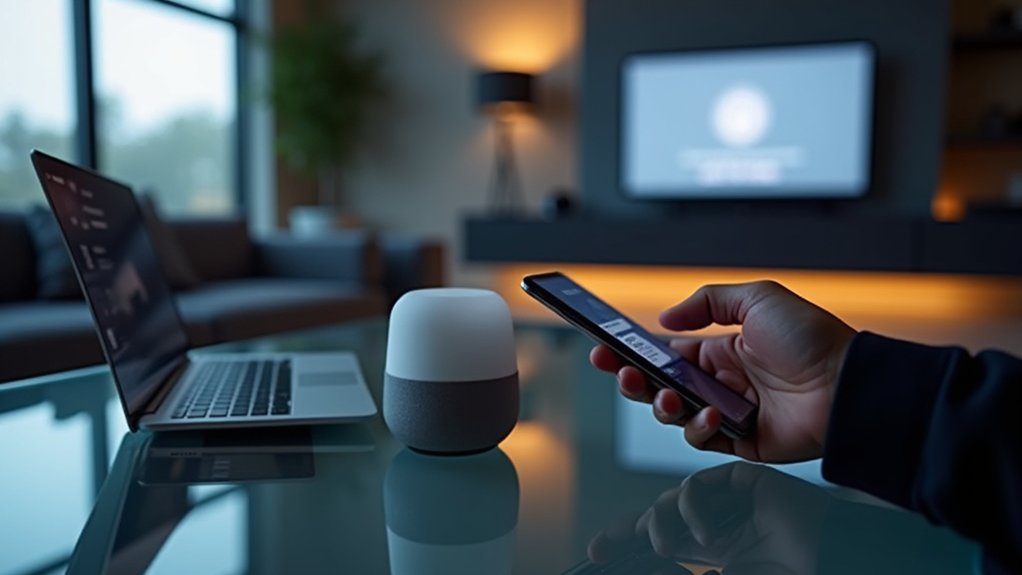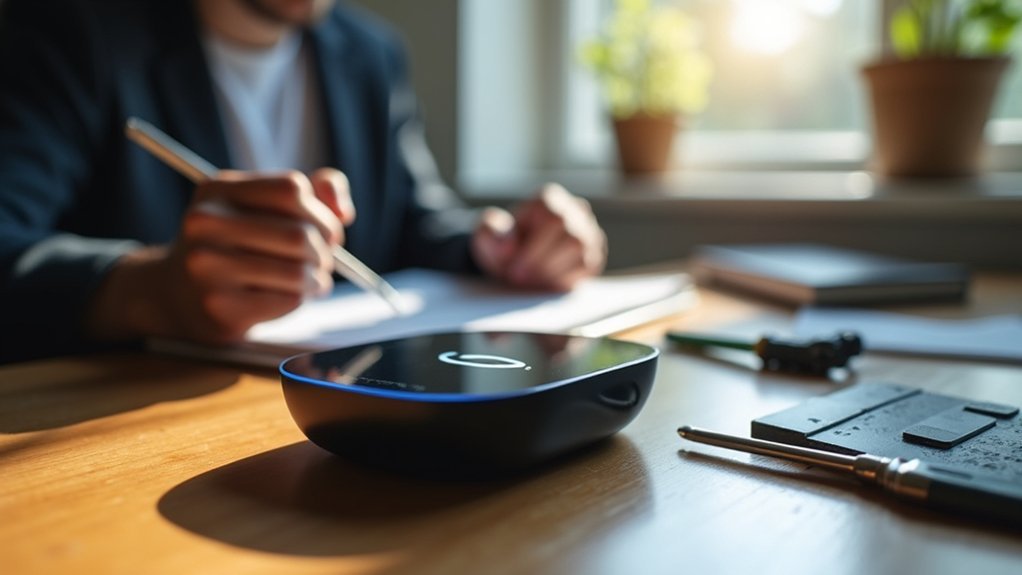To secure self-installed voice assistants, start with proper authentication like voice recognition or PINs. Manage privacy settings by disabling continuous listening and regularly deleting recordings. Secure your network with WPA3 encryption and consider placing devices on a separate guest network. Update firmware regularly, use strong passwords, and enable purchase locks. Teach everyone in your household about safe usage practices and acceptable interactions. The following guide offers extensive strategies to transform your convenient assistant into a fortress of digital security.
Setting Up Proper Authentication for Voice Services

While voice assistants offer unprecedented convenience, their security hinges on robust authentication protocols. You’ll need to choose between active and passive voice authentication methods based on your needs.
Active authentication requires you to recite specific phrases during setup and each login, creating a unique voiceprint that’s difficult to mimic. This method offers strong security but demands your participation.
Passive authentication works silently in the background, analyzing your speech patterns during normal conversations. You won’t need to remember phrases, making it more convenient but potentially less secure.
Consider complementing voice authentication with additional methods like PINs or SMS verification for sensitive functions. Voice authentication technology captures and analyzes unique vocal qualities to create a reference template that’s used for future authentication attempts.
Though voice authentication costs more to implement than traditional methods, it provides excellent accessibility for users who struggle with text-based systems.
Managing Privacy Controls and Data Collection
When it comes to voice assistants, your privacy largely depends on how you manage data collection settings.
Begin by exploring your device’s privacy settings menu, where you can disable unnecessary features and limit when your assistant listens for commands.
Take control of your voice assistant by customizing privacy settings to restrict listening capabilities and disable unneeded functions.
Regularly review and delete stored voice recordings through your app settings.
Consider configuring your device to only listen when you press a physical button rather than constantly listening for wake words.
Carefully manage third-party app permissions, revoking access from unused or untrusted applications to prevent unintended data sharing.
Where possible, choose assistants that offer local processing options, which keep your data within your home network instead of sending everything to the cloud.
Setting up specific wake words can significantly reduce the chance of accidental recordings that might capture sensitive conversations.
Securing Your Network Environment for Voice Devices

Because voice assistants constantly communicate with cloud services, securing your network environment forms the foundation of your device’s overall security posture.
Start by implementing WPA3 encryption on your router and creating strong, unique passwords that you change regularly.
Segment your network by setting up a separate guest network specifically for voice devices and IoT products. This isolation prevents potential breaches from affecting your main network with sensitive data.
Keep your router’s firmware updated to patch vulnerabilities, and disable WPS which can be easily exploited. Voice assistants are particularly vulnerable to cyberattacks and hacking if connected to unsecured networks.
Install a properly configured firewall and intrusion detection system to monitor traffic patterns and block suspicious activities.
When not using your voice assistants, consider turning them off to limit network exposure and regularly review their activity logs.
Configuring Device Settings to Prevent Unauthorized Access
Once your network infrastructure is secure, your attention should turn to the voice assistants themselves. Properly configured device settings create an essential barrier against unauthorized access and privacy invasions.
Configure your devices using these essential steps:
- Personalize wake words and train the assistant to recognize only authorized voices, regularly updating voice profiles as needed to prevent stranger activation. If you experience unintended activations, you can say “Hey Google, that wasn’t for you” to delete unintended interactions.
- Limit device listening by disabling continuous listening, enabling privacy modes, and regularly purging stored recordings with automatic deletion settings.
- Restrict account access by using strong 15+ character passwords with MFA, linking only essential accounts, and regularly auditing third-party permissions.
- Enable all security features including encryption, PIN protection, and purchase locks while keeping firmware updated to patch vulnerabilities.
Educating Household Members on Safe Voice Assistant Usage

Why invest in securing your voice assistant if family members unwittingly compromise its safety? Establish clear guidelines defining acceptable uses and time limits, explaining these rules to promote understanding rather than resistance.
Even the most secure voice assistant is only as protected as your family’s awareness allows it to be.
Teach everyone to manage privacy settings, review recorded interactions, and understand wake word functionality. Emphasize careful responses to avoid sharing sensitive information without parental approval.
Implement strong account protection through 15+ character passwords and multi-factor authentication. Secure your Wi-Fi network, as it’s the gateway to your voice assistant.
For children, enable parental controls and supervise their interactions. Help older or less tech-savvy members use devices confidently but cautiously. Regularly reviewing device logs with children can also serve as an educational opportunity to reinforce concepts of digital privacy and safe technology use.
Create an environment where questions about device responses are encouraged, fostering responsible usage across all age groups.
Frequently Asked Questions
Can Voice Assistants Be Hacked Through Bluetooth Connections?
Yes, your voice assistants can be hacked through Bluetooth. BlueBorne vulnerabilities allow attackers within range to run malicious code, steal data, and control your device. They’re especially vulnerable when Bluetooth can’t be disabled.
How Do I Secure Voice Assistants When Guests Visit My Home?
When guests visit, enable Guest Mode by saying “Hey Google, turn on Guest Mode.” This prevents sharing personal data. Set up Voice Match to authenticate users, disable voice purchasing, and create a guest Wi-Fi network for extra security.
Are Voice Assistants Compatible With VPN Protection?
Yes, you can use VPNs with voice assistants. Most assistants work when connected to VPN-enabled routers. This encrypts your data, protecting your voice commands from interception and enhancing your privacy during daily use.
Can Criminals Use Ultrasonic Commands to Control My Voice Assistant?
Yes, criminals can use ultrasonic commands to control your voice assistant. These inaudible signals (16-22 kHz) can manipulate Alexa, Siri, and others to perform actions without your knowledge or consent.
How Can I Prevent Children From Making Unauthorized Purchases?
Enable purchase verification, set a PIN for voice ordering, and activate kid-friendly modes. Create separate user profiles for children, monitor activity regularly, and turn off voice purchasing when you’re not using it.
In Summary
You’ve learned the essentials of voice assistant security: strong authentication, privacy management, network protection, device hardening, and user education. By implementing these measures, you’re not just buying convenience—you’re creating a secure smart home ecosystem. Remember, your voice assistant’s security is only as strong as your weakest setting. Stay vigilant, update regularly, and you’ll enjoy the benefits of voice technology without compromising your privacy.





Leave a Reply